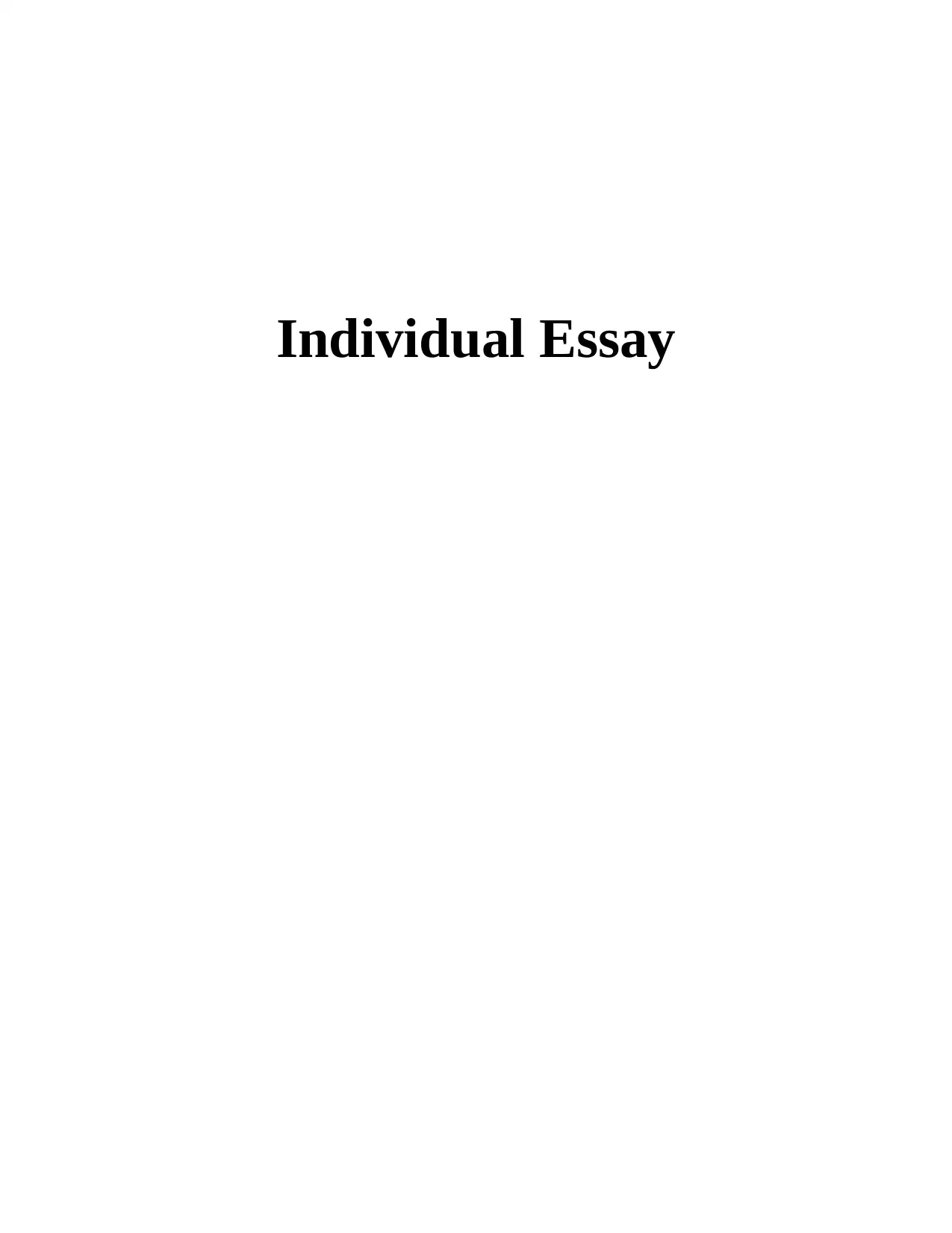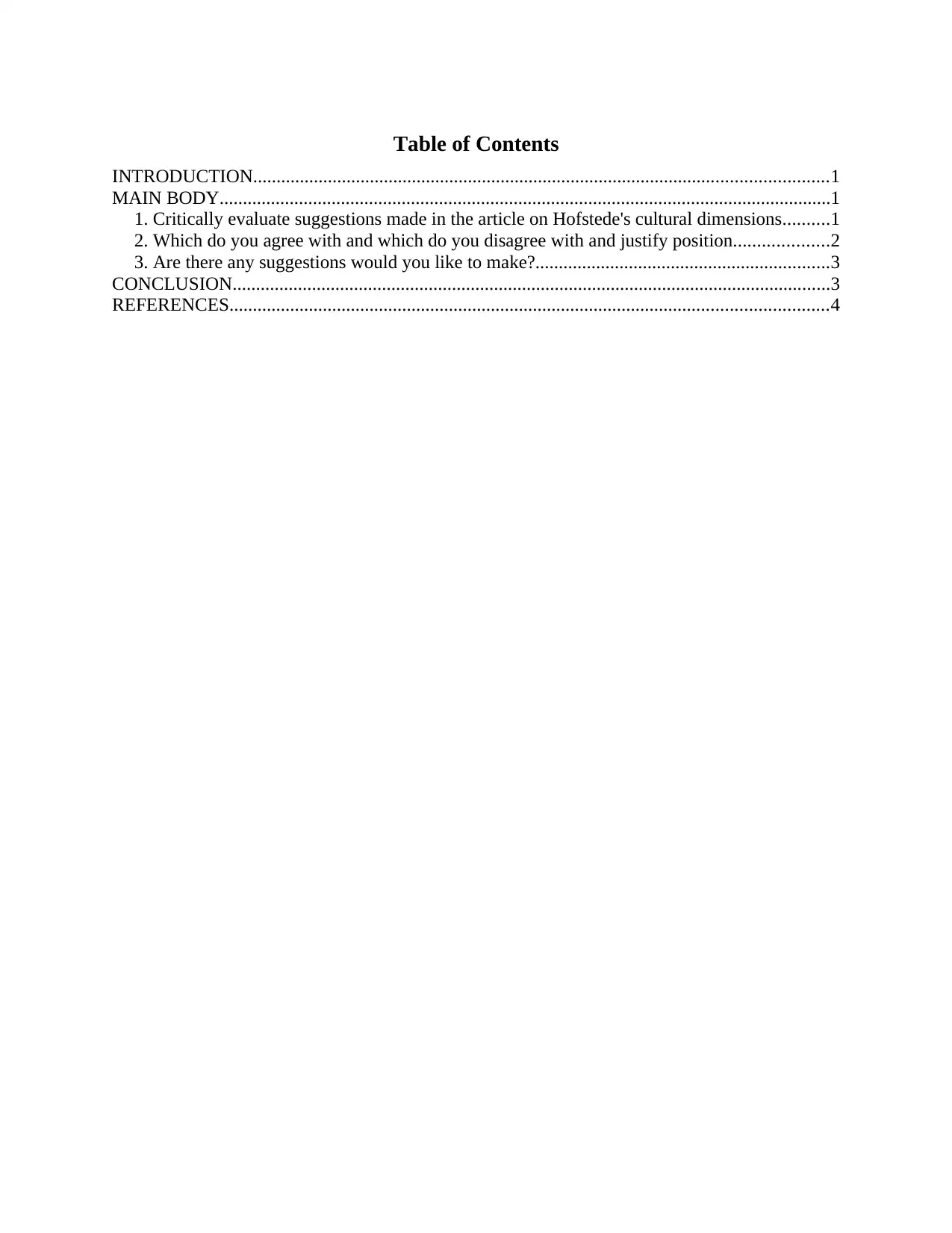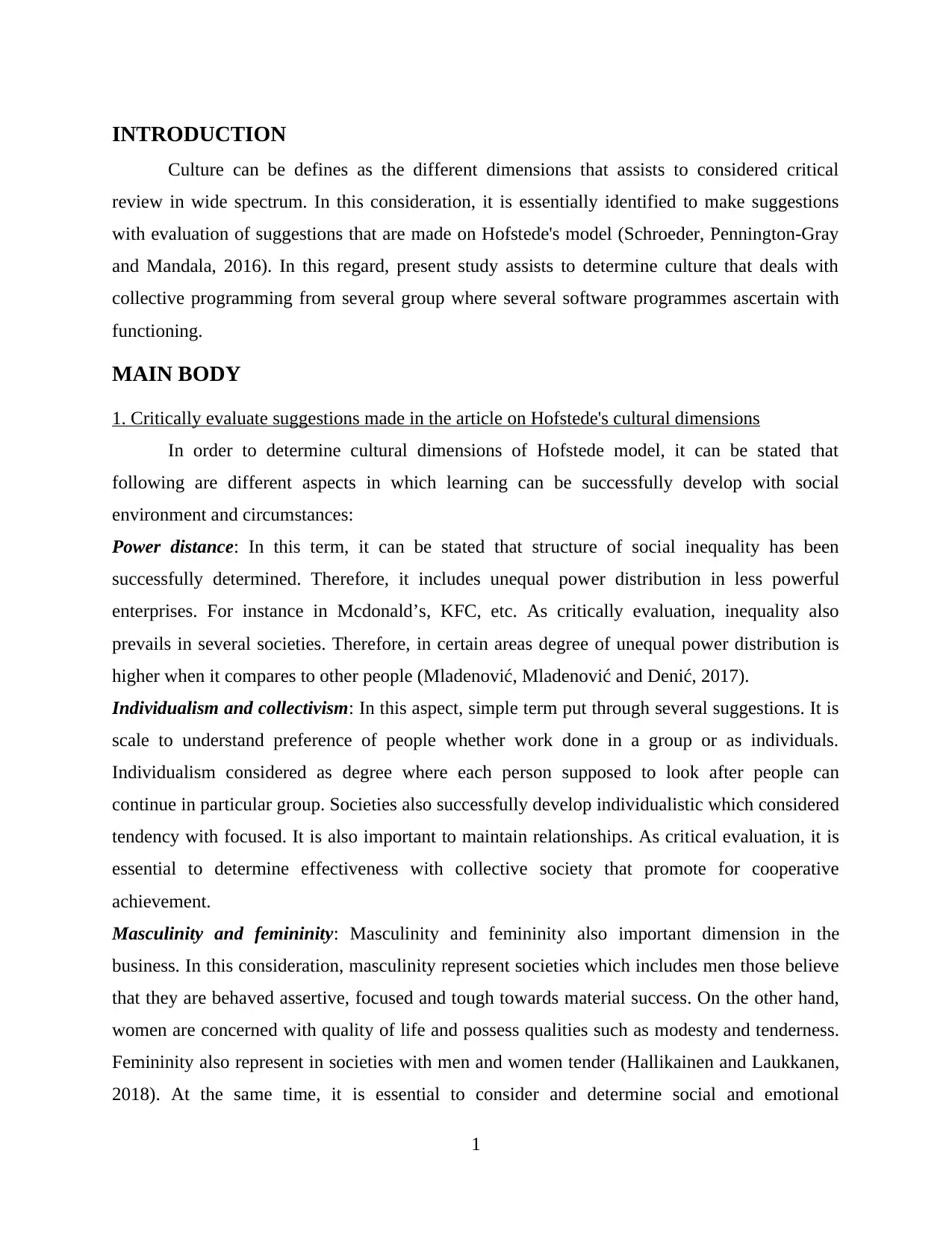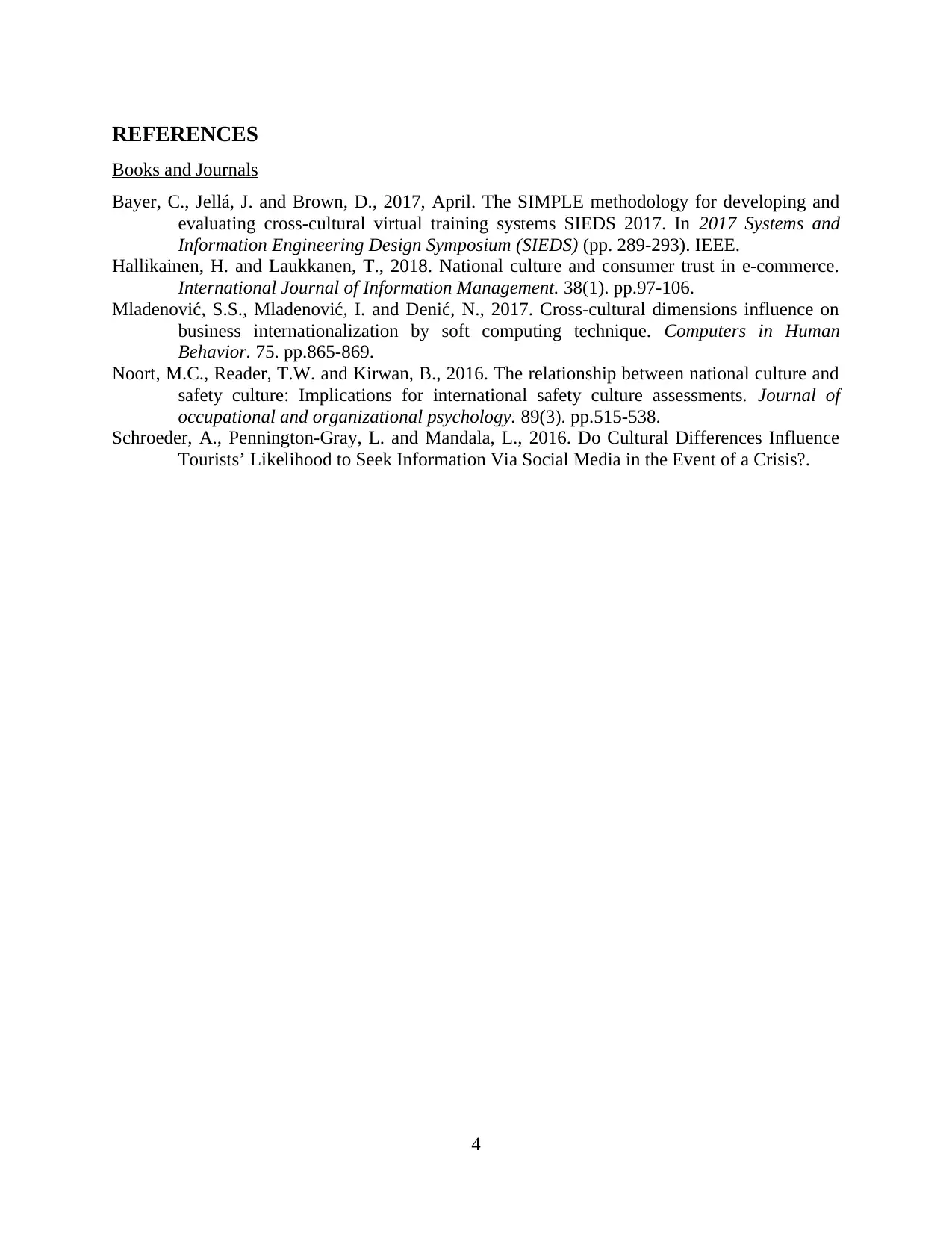Essay: Critically Evaluating Hofstede's Cultural Dimensions Model
VerifiedAdded on 2021/01/02
|6
|1420
|172
Essay
AI Summary
This essay critically evaluates the suggestions made in an article concerning Hofstede's cultural dimensions, providing an in-depth analysis of key aspects such as power distance, individualism vs. collectivism, masculinity vs. femininity, and uncertainty avoidance. The essay delves into the author's agreement and disagreement with these dimensions, justifying their position and offering suggestions for improvement. It emphasizes the impact of these dimensions on business environments, consumer behavior, and organizational cultures. The analysis highlights the importance of understanding these dimensions for effective cross-cultural management and offers insights into how cultural values influence consumer behavior and organizational practices. The conclusion summarizes the findings, emphasizing the significance of Hofstede's model in understanding and navigating cultural differences in a global context.

Individual Essay
Paraphrase This Document
Need a fresh take? Get an instant paraphrase of this document with our AI Paraphraser

Table of Contents
INTRODUCTION...........................................................................................................................1
MAIN BODY...................................................................................................................................1
1. Critically evaluate suggestions made in the article on Hofstede's cultural dimensions..........1
2. Which do you agree with and which do you disagree with and justify position....................2
3. Are there any suggestions would you like to make?...............................................................3
CONCLUSION................................................................................................................................3
REFERENCES................................................................................................................................4
INTRODUCTION...........................................................................................................................1
MAIN BODY...................................................................................................................................1
1. Critically evaluate suggestions made in the article on Hofstede's cultural dimensions..........1
2. Which do you agree with and which do you disagree with and justify position....................2
3. Are there any suggestions would you like to make?...............................................................3
CONCLUSION................................................................................................................................3
REFERENCES................................................................................................................................4

INTRODUCTION
Culture can be defines as the different dimensions that assists to considered critical
review in wide spectrum. In this consideration, it is essentially identified to make suggestions
with evaluation of suggestions that are made on Hofstede's model (Schroeder, Pennington-Gray
and Mandala, 2016). In this regard, present study assists to determine culture that deals with
collective programming from several group where several software programmes ascertain with
functioning.
MAIN BODY
1. Critically evaluate suggestions made in the article on Hofstede's cultural dimensions
In order to determine cultural dimensions of Hofstede model, it can be stated that
following are different aspects in which learning can be successfully develop with social
environment and circumstances:
Power distance: In this term, it can be stated that structure of social inequality has been
successfully determined. Therefore, it includes unequal power distribution in less powerful
enterprises. For instance in Mcdonald’s, KFC, etc. As critically evaluation, inequality also
prevails in several societies. Therefore, in certain areas degree of unequal power distribution is
higher when it compares to other people (Mladenović, Mladenović and Denić, 2017).
Individualism and collectivism: In this aspect, simple term put through several suggestions. It is
scale to understand preference of people whether work done in a group or as individuals.
Individualism considered as degree where each person supposed to look after people can
continue in particular group. Societies also successfully develop individualistic which considered
tendency with focused. It is also important to maintain relationships. As critical evaluation, it is
essential to determine effectiveness with collective society that promote for cooperative
achievement.
Masculinity and femininity: Masculinity and femininity also important dimension in the
business. In this consideration, masculinity represent societies which includes men those believe
that they are behaved assertive, focused and tough towards material success. On the other hand,
women are concerned with quality of life and possess qualities such as modesty and tenderness.
Femininity also represent in societies with men and women tender (Hallikainen and Laukkanen,
2018). At the same time, it is essential to consider and determine social and emotional
1
Culture can be defines as the different dimensions that assists to considered critical
review in wide spectrum. In this consideration, it is essentially identified to make suggestions
with evaluation of suggestions that are made on Hofstede's model (Schroeder, Pennington-Gray
and Mandala, 2016). In this regard, present study assists to determine culture that deals with
collective programming from several group where several software programmes ascertain with
functioning.
MAIN BODY
1. Critically evaluate suggestions made in the article on Hofstede's cultural dimensions
In order to determine cultural dimensions of Hofstede model, it can be stated that
following are different aspects in which learning can be successfully develop with social
environment and circumstances:
Power distance: In this term, it can be stated that structure of social inequality has been
successfully determined. Therefore, it includes unequal power distribution in less powerful
enterprises. For instance in Mcdonald’s, KFC, etc. As critically evaluation, inequality also
prevails in several societies. Therefore, in certain areas degree of unequal power distribution is
higher when it compares to other people (Mladenović, Mladenović and Denić, 2017).
Individualism and collectivism: In this aspect, simple term put through several suggestions. It is
scale to understand preference of people whether work done in a group or as individuals.
Individualism considered as degree where each person supposed to look after people can
continue in particular group. Societies also successfully develop individualistic which considered
tendency with focused. It is also important to maintain relationships. As critical evaluation, it is
essential to determine effectiveness with collective society that promote for cooperative
achievement.
Masculinity and femininity: Masculinity and femininity also important dimension in the
business. In this consideration, masculinity represent societies which includes men those believe
that they are behaved assertive, focused and tough towards material success. On the other hand,
women are concerned with quality of life and possess qualities such as modesty and tenderness.
Femininity also represent in societies with men and women tender (Hallikainen and Laukkanen,
2018). At the same time, it is essential to consider and determine social and emotional
1
⊘ This is a preview!⊘
Do you want full access?
Subscribe today to unlock all pages.

Trusted by 1+ million students worldwide

implications to contribute individual towards society. As critically evaluate, scale is not
particular refer with idea of gender difference. Therefore, it illustrates degree to which
masculinity qualities consider authority, assertiveness, etc. It is generally preferred to female
qualities to maintain relationships with quality of life and services.
Uncertainty avoidance: This dimension explains ways where uncertainty cannot deal effectively.
Therefore, it is relating with control expressions that are emotional in nature. On the other hand,
uncertainty avoidance is the degree which assists to people those are vulnerable in absence of
structure in uncertain events (Noort, Reader and Kirwan, 2016). As critical evaluation, it can be
stated that health and safety rules limited with certain amount of risks that happen in the world.
There is no health and safety rules that are limit to minim pay.
2. Which do you agree with and which do you disagree with and justify position
In order to considered effective cultural dimension, guide or direction towards thinking
and behaviour. With the help of individualism/ collectivism dimension of culture, it can be stated
that high value of individualistic culture positively impact. Collectivist culture value develop
working towards goals and group harmony (Mladenović, Mladenović and Denić, 2017). There
are several elements in higher and lower power distance. Business environment has adopted
forms of management which include participative aspects that place supervisors and subordinates
in moral and equal terms. I am agreed with this culture dimension which assists to tend with high
power and more hierarchical. However, uncertainty avoidance refers with members of society to
respond effectively. In this consideration, high score tend with risk taking in the organisation
(Bayer, Jellá and Brown, 2017). These cultures considered more rules at a particular place that
ensure employees not deviate with acceptable standards. Culture with uncertainty avoidance also
make innovation that are important to achieve success.
Key questions are also involved that how culture affect consumer behaviour in all over
the world. For example, individualism and collectivism index of Hofstede model which influence
different aspects of person (Schroeder, Pennington-Gray and Mandala, 2016). For example,
purchasing of clothing, electronic items, etc. These elements considered in it for which I am not
agreed. According to the position, it can be stated that culture of the country also influence in
significant manner in particular business environment. Furthermore, this model also describe
cultural values of people in different nations because organisational cultures are different.
Culture of employees is different with organisational culture. Therefore, in global business
2
particular refer with idea of gender difference. Therefore, it illustrates degree to which
masculinity qualities consider authority, assertiveness, etc. It is generally preferred to female
qualities to maintain relationships with quality of life and services.
Uncertainty avoidance: This dimension explains ways where uncertainty cannot deal effectively.
Therefore, it is relating with control expressions that are emotional in nature. On the other hand,
uncertainty avoidance is the degree which assists to people those are vulnerable in absence of
structure in uncertain events (Noort, Reader and Kirwan, 2016). As critical evaluation, it can be
stated that health and safety rules limited with certain amount of risks that happen in the world.
There is no health and safety rules that are limit to minim pay.
2. Which do you agree with and which do you disagree with and justify position
In order to considered effective cultural dimension, guide or direction towards thinking
and behaviour. With the help of individualism/ collectivism dimension of culture, it can be stated
that high value of individualistic culture positively impact. Collectivist culture value develop
working towards goals and group harmony (Mladenović, Mladenović and Denić, 2017). There
are several elements in higher and lower power distance. Business environment has adopted
forms of management which include participative aspects that place supervisors and subordinates
in moral and equal terms. I am agreed with this culture dimension which assists to tend with high
power and more hierarchical. However, uncertainty avoidance refers with members of society to
respond effectively. In this consideration, high score tend with risk taking in the organisation
(Bayer, Jellá and Brown, 2017). These cultures considered more rules at a particular place that
ensure employees not deviate with acceptable standards. Culture with uncertainty avoidance also
make innovation that are important to achieve success.
Key questions are also involved that how culture affect consumer behaviour in all over
the world. For example, individualism and collectivism index of Hofstede model which influence
different aspects of person (Schroeder, Pennington-Gray and Mandala, 2016). For example,
purchasing of clothing, electronic items, etc. These elements considered in it for which I am not
agreed. According to the position, it can be stated that culture of the country also influence in
significant manner in particular business environment. Furthermore, this model also describe
cultural values of people in different nations because organisational cultures are different.
Culture of employees is different with organisational culture. Therefore, in global business
2
Paraphrase This Document
Need a fresh take? Get an instant paraphrase of this document with our AI Paraphraser

national culture determined value that reflect on the national culture. As a result, it is essential to
understand importance of consumer behaviour. Statistical credibility of this model support to
bring work scholars which assists to satisfy replications of research and data collecting method.
As a position of manager, it is essential to deal with different aspects of cultural dimensions. It
assists to focus on culture based values, norms and behaviour (Noort, Reader and Kirwan, 2016).
Therefore, it assists to understand consumer behaviour in systematic manner.
3. Are there any suggestions would you like to make?
In order to considered appropriate suggestions, it can be stated that following are
different suggestions ascertained with organisation culture. In this regard, values, norms and
behaviour successfully implemented to accomplish behavioural expectations that considered
high degree of specificity and clarity which required for desirable behaviour (Hallikainen and
Laukkanen, 2018). In appropriate form of policies and procedures, changes are accelerating in
social media and sharing. Furthermore, sharing ideas and opinion among different people helps
to consider marketing for organisation and understand consumer behaviour.
CONCLUSION
From the above report, it can be concluded that Hofstede model of different cultural
dimensions assists to determine norms behavioural expectations. High degree of specificity and
clarity required desirable behaviour in consideration of policies and procedures. Furthermore, it
summarised about different cultural dimension that helps to understand appropriate work which
demonstrate managers participation in business. Moreover, individualism and collectivism
dimension is the main aspect with businesses can work to accelerating changes in
communication. At last, suggestions are made to understand organisation and consumer
behaviour.
3
understand importance of consumer behaviour. Statistical credibility of this model support to
bring work scholars which assists to satisfy replications of research and data collecting method.
As a position of manager, it is essential to deal with different aspects of cultural dimensions. It
assists to focus on culture based values, norms and behaviour (Noort, Reader and Kirwan, 2016).
Therefore, it assists to understand consumer behaviour in systematic manner.
3. Are there any suggestions would you like to make?
In order to considered appropriate suggestions, it can be stated that following are
different suggestions ascertained with organisation culture. In this regard, values, norms and
behaviour successfully implemented to accomplish behavioural expectations that considered
high degree of specificity and clarity which required for desirable behaviour (Hallikainen and
Laukkanen, 2018). In appropriate form of policies and procedures, changes are accelerating in
social media and sharing. Furthermore, sharing ideas and opinion among different people helps
to consider marketing for organisation and understand consumer behaviour.
CONCLUSION
From the above report, it can be concluded that Hofstede model of different cultural
dimensions assists to determine norms behavioural expectations. High degree of specificity and
clarity required desirable behaviour in consideration of policies and procedures. Furthermore, it
summarised about different cultural dimension that helps to understand appropriate work which
demonstrate managers participation in business. Moreover, individualism and collectivism
dimension is the main aspect with businesses can work to accelerating changes in
communication. At last, suggestions are made to understand organisation and consumer
behaviour.
3

REFERENCES
Books and Journals
Bayer, C., Jellá, J. and Brown, D., 2017, April. The SIMPLE methodology for developing and
evaluating cross-cultural virtual training systems SIEDS 2017. In 2017 Systems and
Information Engineering Design Symposium (SIEDS) (pp. 289-293). IEEE.
Hallikainen, H. and Laukkanen, T., 2018. National culture and consumer trust in e-commerce.
International Journal of Information Management. 38(1). pp.97-106.
Mladenović, S.S., Mladenović, I. and Denić, N., 2017. Cross-cultural dimensions influence on
business internationalization by soft computing technique. Computers in Human
Behavior. 75. pp.865-869.
Noort, M.C., Reader, T.W. and Kirwan, B., 2016. The relationship between national culture and
safety culture: Implications for international safety culture assessments. Journal of
occupational and organizational psychology. 89(3). pp.515-538.
Schroeder, A., Pennington-Gray, L. and Mandala, L., 2016. Do Cultural Differences Influence
Tourists’ Likelihood to Seek Information Via Social Media in the Event of a Crisis?.
4
Books and Journals
Bayer, C., Jellá, J. and Brown, D., 2017, April. The SIMPLE methodology for developing and
evaluating cross-cultural virtual training systems SIEDS 2017. In 2017 Systems and
Information Engineering Design Symposium (SIEDS) (pp. 289-293). IEEE.
Hallikainen, H. and Laukkanen, T., 2018. National culture and consumer trust in e-commerce.
International Journal of Information Management. 38(1). pp.97-106.
Mladenović, S.S., Mladenović, I. and Denić, N., 2017. Cross-cultural dimensions influence on
business internationalization by soft computing technique. Computers in Human
Behavior. 75. pp.865-869.
Noort, M.C., Reader, T.W. and Kirwan, B., 2016. The relationship between national culture and
safety culture: Implications for international safety culture assessments. Journal of
occupational and organizational psychology. 89(3). pp.515-538.
Schroeder, A., Pennington-Gray, L. and Mandala, L., 2016. Do Cultural Differences Influence
Tourists’ Likelihood to Seek Information Via Social Media in the Event of a Crisis?.
4
⊘ This is a preview!⊘
Do you want full access?
Subscribe today to unlock all pages.

Trusted by 1+ million students worldwide
1 out of 6
Related Documents
Your All-in-One AI-Powered Toolkit for Academic Success.
+13062052269
info@desklib.com
Available 24*7 on WhatsApp / Email
![[object Object]](/_next/static/media/star-bottom.7253800d.svg)
Unlock your academic potential
Copyright © 2020–2025 A2Z Services. All Rights Reserved. Developed and managed by ZUCOL.





